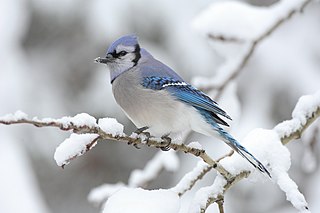Related Research Articles

The blue jay is a passerine bird in the family Corvidae, native to eastern North America. It lives in most of the eastern and central United States; eastern populations may be migratory. Resident populations are also found in Newfoundland, Canada; breeding populations are found across southern Canada. It breeds in both deciduous and coniferous forests, and is common in residential areas. It is predominantly blue, with a white chest and underparts and a blue crest; it has a black, U-shaped collar around its neck and a black border behind the crest. Males and females are similar in size and plumage, and plumage does not vary throughout the year. Four subspecies have been recognized.

The crested lark is a species of lark distinguished from the other 81 species of lark by the crest of feathers that rise up in territorial or courtship displays and when singing. Common to mainland Europe, the birds can also be found in northern Africa and in parts of western Asia and China. It is a non-migratory bird, but can occasionally be found as a vagrant in Great Britain.

The hooded seal is a large phocid found only in the central and western North Atlantic, ranging from Svalbard in the east to the Gulf of St. Lawrence in the west. The seals are typically silver-grey or white in color, with black spots that vary in size covering most of the body. Hooded seal pups are known as "blue-backs" because their coats are blue-grey on the back with whitish bellies, though this coat is shed after 14 months of age when the pups molt.

Celosia argentea, commonly known as the plumed cockscomb or silver cock's comb, is a herbaceous plant of tropical origin, and is known for its very bright colors. In India and China it is known as a troublesome weed.

The crested porcupine also known as the African crested porcupine, is a species of rodent in the family Hystricidae found in Italy, North Africa, and sub-Saharan Africa.

The crested servaline genet, also known as the crested genet, is a genet species endemic to Nigeria and Cameroon. As the population has declined due to loss of habitat, it is listed as Vulnerable on the IUCN Red List. It was first recorded in the Mamfe Division in Cameroon and initially considered a subspecies of the servaline genet. But now it is regarded as a distinct species.

Macaduma is a genus of moths in the subfamily Arctiinae.

Lepiota cristata, commonly known as the stinking dapperling or the stinking parasol, is an agaric and possibly poisonous mushroom in the family Agaricaceae. A common and widespread species—one of the most widespread fungi in the genus Lepiota—it has been reported from Europe, northern Asia, North America, and New Zealand. It fruits on the ground in disturbed areas, such as lawns, path and road edges, parks, and gardens. The species produces fruit bodies characterized by the flat, reddish-brown concentric scales on the caps, and an unpleasant odour resembling burnt rubber. Similar Lepiota species can sometimes be distinguished from L. cristata by differences in cap colour, stipe structure, or odour, although some species can only be reliably distinguished through the use of microscopy.
Macaduma biangulata is a moth of the subfamily Arctiinae. It was described by Jeremy Daniel Holloway in 1979. It is found in New Caledonia.
Macaduma feliscaudata is a moth of the subfamily Arctiinae. It was described by David Stephen Fletcher in 1957. It is found on Rennell Island.
Macaduma fuliginosa is a moth of the subfamily Arctiinae. It was described by Rothschild in 1912. It is found in New Guinea.
Neoduma simplex is a moth of the subfamily Arctiinae. It was described by Pagenstecher in 1900. It is found in New Britain.
Macaduma lichenia is a moth of the subfamily Arctiinae. It was described by Rothschild in 1912. It is found in New Guinea.
Macaduma quercifolia is a moth of the subfamily Arctiinae. It was described by Rothschild in 1912. It is found in New Guinea.
Macaduma reducta is a moth in the subfamily Arctiinae. It was described by Walter Rothschild in 1912. It is found on Fergusson Island in Papua New Guinea.
Macaduma subfoliacea is a moth of the subfamily Arctiinae. It was described by Rothschild in 1916. It is found in Volcan Island.
Macaduma postflavida is a moth of the subfamily Arctiinae. It was described by Rothschild in 1916. It is found on the Dampier Archipelago.
Macaduma montana is a moth of the subfamily Arctiinae. It was described by Robinson in 1975. It is found on Fiji.
Macaduma striata is a moth of the subfamily Arctiinae. It was described by Robinson in 1975. It is found on Fiji.
Macaduma samoensis is a moth of the subfamily Arctiinae. It was described by Tams in 1935. It is found on Samoa.
References
- ↑ Beccaloni, G.; Scoble, M.; Kitching, I.; Simonsen, T.; Robinson, G.; Pitkin, B.; Hine, A.; Lyal, C., eds. (2003). "Macaduma cristata". The Global Lepidoptera Names Index . Natural History Museum . Retrieved May 8, 2018.
| This Lithosiini-related article is a stub. You can help Wikipedia by expanding it. |